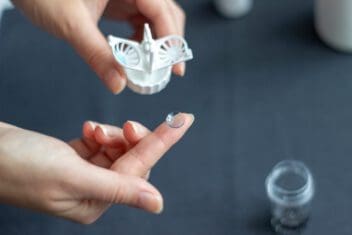Toric Contact Lenses: Are They Right for You? (Pros & Cons)
Home / Understanding Contacts /
Last Updated:
If you have astigmatism, you may be tired of wearing glasses, but hard contact lenses are not the best for eye health. Soft toric contact lenses are a good option for many people with astigmatism, allowing them to get rid of their glasses.
Table of Contents
People with mild to moderate corneal astigmatism, low levels of other refractive errors, and generally good eye health are good candidates for toric lenses.
Downsides include the lenses’ mobility in the eyes, which can make vision blurry or inconsistent. Toric lenses are also more expensive than regular contact lenses.
If you are willing to take the extra time with your optometrist to fit toric contact lenses properly, they can be a good choice to manage your astigmatism.
What Are Toric Contact Lenses?

Astigmatism is one of the more common types of refractive errors, or structural problems with your cornea or lens. It leads to light hitting your retina in a way that does not create a clear image of the world.
If you have astigmatism, either your cornea or lens will be shaped in a more oblong fashion, like a football, rather than shaped like a circle. This can cause general blurry vision. If your sight is not corrected well, you can suffer from eye strain, discomfort, or headaches.
You deserve clear vision. We can help.
With 135+ locations and over 2.5 million procedures performed, our board-certified eye surgeons deliver results you can trust.
Your journey to better vision starts here.
Corneal astigmatism, or a misshapen cornea, can be corrected well with certain types of contact lenses. While lenticular astigmatism, or a misshapen lens in your eye, is better served with glasses, corneal astigmatism can benefit from a contact lens that actually reshapes the cornea to improve your visual clarity.
One type of lens that can improve mild and moderate corneal astigmatism is a toric lens. These contact lenses are soft contacts, which are more gas permeable than hard contacts. For years, hard contacts have been the preferred treatment for astigmatism to help reshape the eye, but soft contacts allow for better long-term eye health. Because of this, toric contact lenses can be a good option.
Popular Brands of Toric Lenses
Toric lenses give wearers the richest and most vibrant colors imaginable. They provide premium enhanced progressive natural eye movement, a smooth transitional zone and clear vision at all distances.
Some of the popular brands of toric lenses are:
- Acuvue Oasys for Astigmatism Contact Lenses
- Biofinity Toric Contact Lenses
- Air Optix for Astigmatism Contact Lenses
- Proclear Multifocal Toric Contact Lenses
- Dailies AquaComfort Plus Toric – Contact Lenses
Who Is Best Suited for Toric Contact Lenses?
Some people have astigmatism in addition to other refractive errors like nearsightedness or farsightedness. People who treat one refractive error may wear soft contacts that do not treat their astigmatism. If you want to wear contact lenses and have astigmatism, toric lenses are a great option to correct corneal shape while also correcting other refractive errors.
Toric contact lenses use specific meridians to stay in place and improve your visual acuity. Meridians are measured from your pupil out, like a radius in a circle. These meridians are measured to specific powers to correct your astigmatism.
There are also design elements like slightly weighted or thickened edges to help keep these soft lenses in place. Usually, these weights are at the 6 o’clock and 12 o’clock axes.
There are also different brands of toric contact lenses, which offer different fits. If you try one brand and it does not situate properly in your eye, another brand is likely to suit your needs.
A study published in 2013 examined three groups of people (200 subjects) with astigmatism who had not worn contact lenses before. Over a one-month trial involving daily wear soft contact lenses, 88 percent of toric lenses fit on the first attempt. While there were reports of discomfort and visual problems leading to some participants quitting the use of the contacts, most reported that their overall vision was as good as with glasses.
Toric Contacts vs. Traditional Glasses for Astigmatism
When you have low to moderate astigmatism, simple soft or RGP lenses can neutralize it with relative ease. Doctors prefer toric lenses to correct severe amounts of astigmatism.
Toric contacts are designed to align with the 6 to 12 o’clock axis. After inserting them into your eyes, blinking makes the lenses rotate and adjust while the weight makes it position itself to its proper alignment. This can sometimes be irritating to users. Of course, traditional glasses do not have this problem.
Generally, many people prefer hard lenses to soft options. But technological advancements and newer designs have greatly improved the comfort and vision that soft lenses can achieve. That’s why toric contact lenses are definitely worth a try if you have astigmatism.
Large amounts of progressive astigmatism may also indicate other underlying conditions like keratoconus. These astigmatisms can be treated by using specially designed GPC contacts.
You deserve clear vision. We can help.
With 135+ locations and over 2.5 million procedures performed, our board-certified eye surgeons deliver results you can trust.
Your journey to better vision starts here.
The Downsides to Toric Contact Lenses

Although toric soft contact lenses work very well for many people with mild or moderate astigmatism, they are still not a perfect solution.
For example, although toric lenses are weighted in certain places, they can still slip out of alignment fairly often. Anyone who wears contact lenses will shift these devices in their eyes when they blink. Standard soft contacts are designed to shift without changing your ability to see, but this does not work for people with astigmatism. Even with weighted sides to return them to their original position, your vision can still be uncomfortable or blurry for a few moments. Since you need to blink so frequently throughout the day, this may be too disruptive to your daily life.
Toric contact lenses also only work for people with corneal astigmatism. Those who have lenticular astigmatism need glasses to treat this condition. The lens is inside the eye, behind the pupil, so it cannot be directly reshaped with a contact lens.
Toric contact lenses are more expensive than standard soft contacts. Depending on the distributor, you may pay as much as 35 percent more for these lenses. Your vision insurance may cover some of this cost, but you will likely end up paying more out of pocket than you would for a pair of prescription glasses.
Reasons most cited for toric contact lenses not being a good option for many people with astigmatism include:
- Consistently poor fit regardless of material or brand.
- The fit being too individual, making it hard to find the right brand or size.
- Lots of time spent in the chair at your eye doctor’s office.
- More money spent out of pocket.
- Power limitations for correcting astigmatism and other refractive errors.
- Lens fit needs to be rechecked every year.
Ultimately, toric lenses require more initial work since the fit is more specific. This means you may need to visit your eye doctor more frequently, resulting in more fees in addition to the higher cost of these lenses.
Despite these downsides, the benefits of toric lenses are substantial for some people.
Work With Your Optometrist for the Best Toric Contact Lens Fit
For a long time, contact lenses were not the preferred way to improve visual acuity in people with astigmatism. However, as technology progresses, toric soft contact lenses are a great option for people with mild to moderate corneal astigmatism.
If you are interested in these types of lenses, work with your optometrist or ophthalmologist to have toric lenses fitted properly to your eyes. Be aware that this can take some extra time or extra visits, but it is well worth it.
Toric contact lenses also cost a little more, but the price difference can be worthwhile for clear vision without glasses.
If you know what to expect beforehand, you can then assess if the pros of toric lenses are worth the potential cons. Talk to your eye doctor at your next exam about whether they could be right for you.
Where Can You Buy Toric Contacts?
Toric contacts are available across the globe. You can find the best toric contact lenses that suit your eyes and vision on several certified online earwear platforms. You can also find contacts that give you maximum exposure at your local optical stores.
We also recommend you consult with your eye care doctor about the best toric contact lenses to use. Your doctor will likely prescribe brands that do not react with your eyes or cause more eye problems.
Your optometrist will suggest the best toric contact lenses for your eyes and eye condition and fit them properly to your eyes. You must also note that this process usually takes time and may require several visits to your eye care doctor.
You deserve clear vision. We can help.
With 135+ locations and over 2.5 million procedures performed, our board-certified eye surgeons deliver results you can trust.
Your journey to better vision starts here.
References
- What Is Astigmatism? (August 2018). American Academy of Ophthalmology (AAO).
- Toric Contact Lenses for Astigmatism. Hopkins Eye Center.
- Which Is Better for Astigmatism – Glasses or Contacts? (July 2015). American Academy of Ophthalmology (AAO).
- Clinical Evaluation of Fitting Toric Soft Contact Lenses to Current Non-Users. (March 2013). Ophthalmic and Physiological Optics.
- What Are Toric Contact Lenses, When Are They Used And What Are the Risks and Benefits of Using Them? (August 2009). ABC News.
- Five Reasons ODs Don’t Fit Toric Contact Lenses. (May 2017). Optometry Times.
- Astigmatism. (February 22, 2007). National Eye Institute.
- What Is Keratoconus? (October 21, 2020). American Academy of Ophthalmology.
- Which Is better for astigmatism—glasses or contacts? (July 21, 2015). American Academy of Ophthalmology.
- Blindness and vision impairment: Refractive errors. (October 6, 2013). World Health Organization.
This content is for informational purposes only. It may have been reviewed by a licensed physician, but is not intended to serve as a substitute for professional medical advice. Always consult your healthcare provider with any health concerns. For more, read our Privacy Policy and Editorial Policy.
